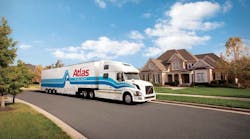I've often wondered how some fleets can afford to assign one tractor to one driver. Now I know the answer — they can't.
Sure times are good right now if you're a truckload carrier with tight freight capacity ensuring decent profitability for most. On the surface, it looks like consolidation in that segment of the for-hire market has brought increased productivity and therefore profitability to the surviving big players.
But if you look beyond the quarterly reports, you'll see this welcome, and uncharacteristic, condition isn't due to superior business strategies. As a new white paper from industry analyst Duff Swain of the Trincon Group points out, the current freight capacity shortage is really “the result of a driver shortage, and not the consequence of efficient business operations on the part of the carriers.”
If you don't believe him, then consider this — when truckload consolidation peaked between 2003 and 2005, operating miles per truck actually dropped. In other words, there were fewer fleets, but they were operating the same number of trucks.
Transportation is a capital-intensive business. Have you ever heard of a train sitting on a siding because the engineer had run out of hours? Or of a jet flown by just one pilot? Those revenue-generating assets are just too expensive to sit idle. Every available hour has to be “sold” to achieve the kind of productivity that brings long-term profitability.
Swain's argument for higher equipment utilization by truckload carriers is straightforward. Under current tax laws trucks can be depreciated over three years, and they usually have a warranty life of 700,000 miles. Therefore, a carrier has to run its trucks 700,000 miles in three years to take full advantage of that significant tax advantage. The only way to get that many miles is to run the trucks 24/7, which means slip-seating and multi-shift operations. That's a lesson LTL operations like FedEx and UPS learned long ago, Swain points out.
But if you can't get drivers now to fill all the assigned trucks in your fleet, how are you ever going to find enough to run them around the clock?
Luring more drivers to drive more trucks just perpetuates the “one-driver-one-truck” mindset, Swain argues. Instead, carriers need to reduce turnover dramatically and keep the drivers they have while also attracting new ones who will stick around.
Here's where Swain closes the circle. If you can increase the productivity of your underutilized capital — those trucks not running 700,000 miles in three years — you will lower your operating costs, allowing you to market your services and negotiate with those who need them from a more competitive position. The profits and tax-savings that result can be reinvested to recruit and retain the stable driver workforce that supports that increased productivity.
Theory never translates into practice easily, and it's especially hard to throw over what's become accepted practice by both drivers and fleet managers. But if you don't figure out the formula that allows you to get the most out of your expensive capital investments and change the game for the better for your drivers, your competitors will. And you won't survive if their profitability is based on sound business practices, while yours remains tied to the rising and falling cycles of the marketplace.
E-mail: [email protected]
Web site: fleetowner.com


